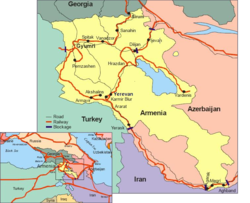| Crossroads of Peace | |
|---|---|
 | |
| Overview | |
| Status | Proposed |
| Locale | |
The Crossroads of Peace [a] is a transportation project, proposed by the Armenian government in October 2023, which seeks to improve Armenia's links to neighboring Azerbaijan, Georgia, Iran and Turkey, [1] [2] [3] and to restore cooperation in the region and promote mutual understanding among nations. [4] Currently, due to the ongoing Turkish-Azeri blockade against Armenia, direct transit through the region is hampered.
Contents
The project has been positioned as complementary to the International North–South Transport Corridor. [5]
